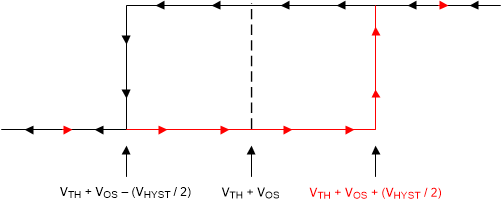ZHCSOE4B December 2022 – September 2024 TLV1851 , TLV1852 , TLV1854 , TLV1861 , TLV1862 , TLV1864
PRODMIX
- 1
- 1 特性
- 2 应用
- 3 说明
- 4 Pin Configuration and Functions
- 5 Specifications
- 6 Detailed Description
- 7 Application and Implementation
- 8 器件和文档支持
- 9 Revision History
- 10Mechanical, Packaging, and Orderable Information
7.1.2 Hysteresis
The basic comparator configuration may produce a noisy "chatter" output if the applied differential input voltage is near the comparator's offset voltage. This usually occurs when the input signal is moving very slowly across the switching threshold of the comparator. This problem can be prevented by adding external hysteresis to the comparator.
Since the TLV185x and TLV186x devices only have a minimal amount of internal hysteresis of 2.7mV, external hysteresis can be applied in the form of a positive feedback loop that adjusts the trip point of the comparator depending on its current output state.
The hysteresis transfer curve is shown in Figure 7-2. This curve is a function of three components: VTH, VOS, and VHYST:
- VTH is the actual set voltage or threshold trip voltage.
- VOS is the internal offset voltage between VIN+ and VIN–. This voltage is added to VTH to form the actual trip point at which the comparator must respond to change output states.
- VHYST is the hysteresis (or trip window) that is designed to reduce comparator sensitivity to noise.
 Figure 7-2 Hysteresis Transfer Curve
Figure 7-2 Hysteresis Transfer CurveFor more information, please see Application Note SBOA219 "Comparator with and without hysteresis circuit".